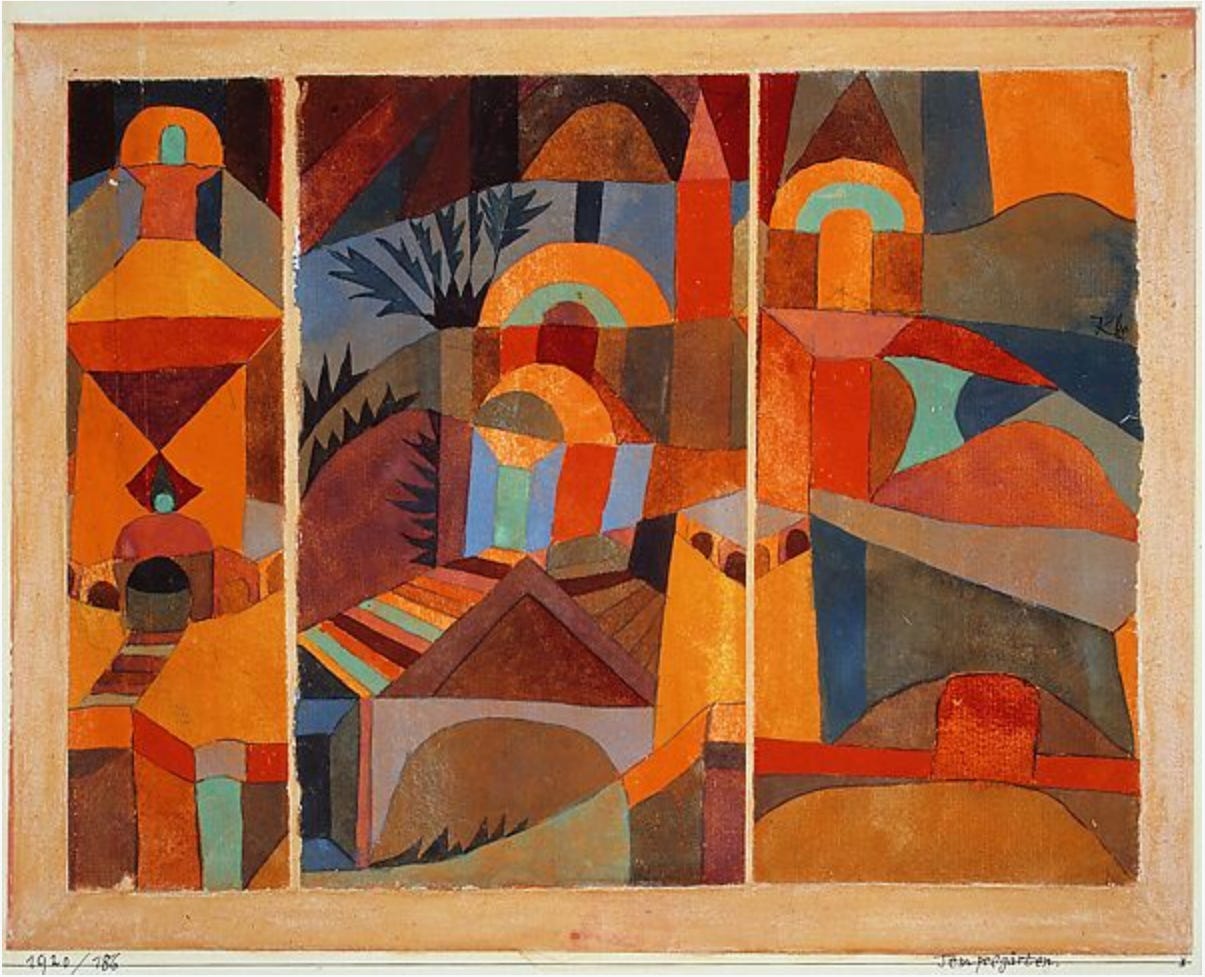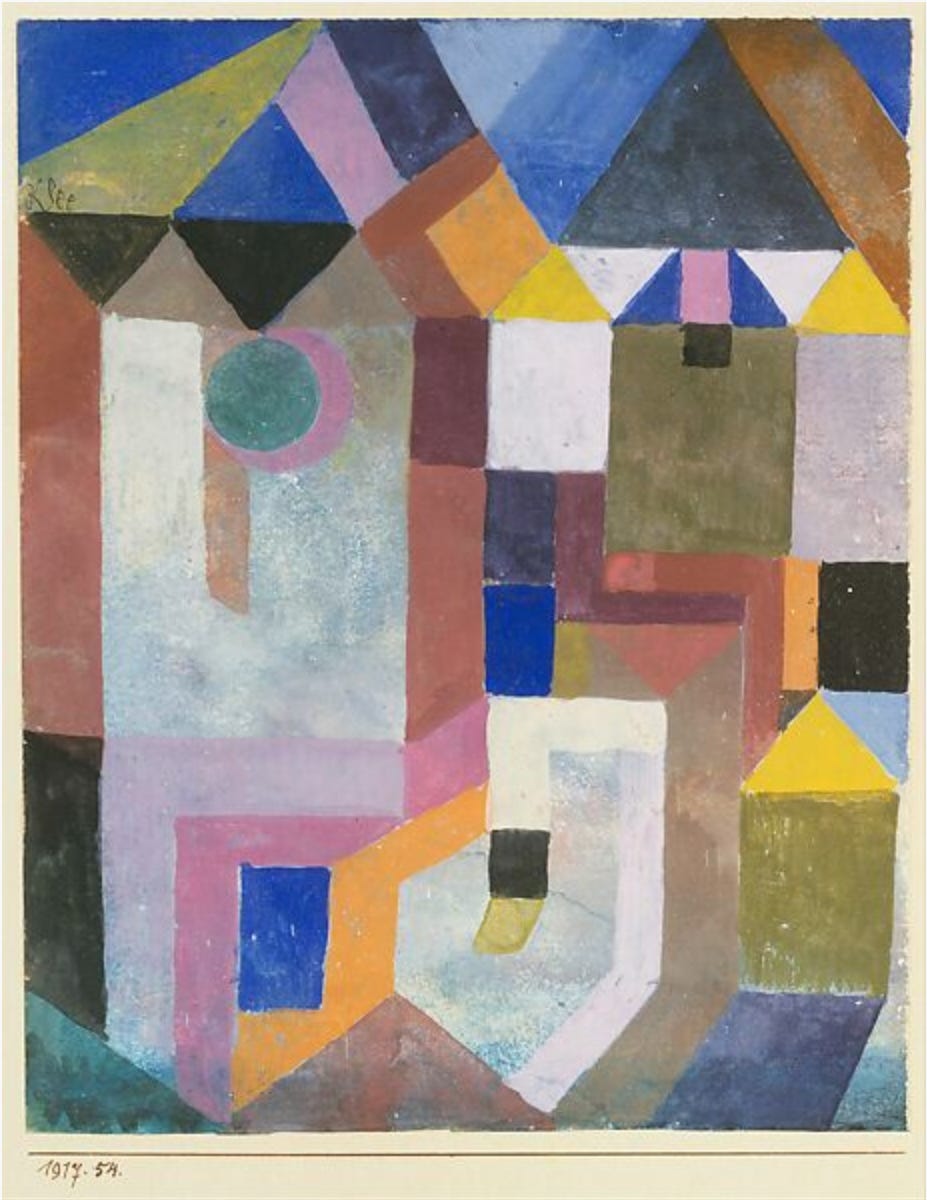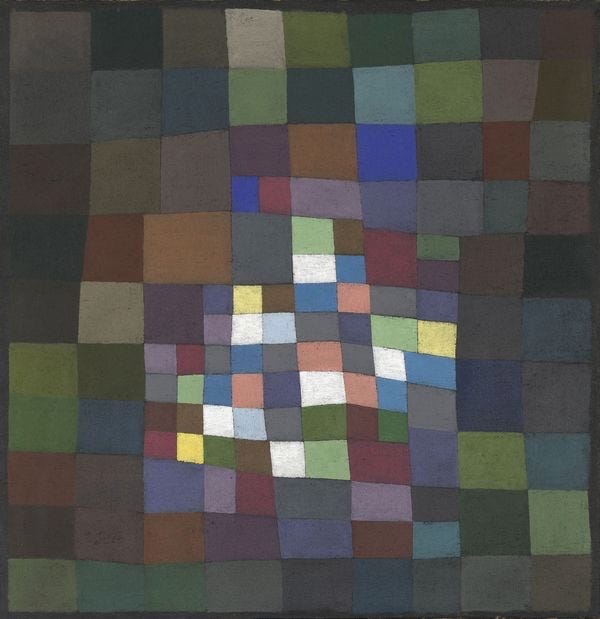Although patterns are everywhere in daily life, we don’t always associate them with fine art. Paul Klee masterfully used pattern to create rhythm, movement, and structure in his paintings. His geometric forms—squares, triangles, and circles—combine in intricate, often playful compositions. Like a musical beat, his repeating shapes guide the eye, creating a sense of harmony and flow.
In Castle and Sun (pictured above), Klee used geometric shapes to construct an abstract castle, reducing architecture to its essential forms. His use of color and pattern evoke a sense of mood and emotion, transforming simple shapes into a vibrant, almost dreamlike composition. The interplay of warm and cool tones, along with the rhythmic arrangement of forms, creates a dynamic yet harmonious scene.
In 1914, Klee spent two transformative weeks in Tunisia, a journey that reshaped his approach to painting. The region’s intense light and vibrant colors deeply affected him, inspiring a shift away from naturalism. Instead of using color to depict reality, he began to explore its expressive potential, treating it as an independent element within his compositions. This breakthrough led him further into abstraction, where color and form work together to evoke mood and rhythm.
Temple Gardens (pictured above) reflects the influence of Klee’s time in Tunisia. In this painting, he constructed stairs from simple stripes and domed towers from arch-like forms, creating a whimsical, dreamlike scene. Above the garden walls, stylized palm trees emerge, adding to the painting’s sense of place while maintaining his signature abstraction.
According to a blurb on The Metropolitan Museum of Art’s website:
Klee sometimes liked to rearrange his compositions with scissors. Perhaps in this instance (Temple Gardens), he thought the work looked too symmetrical and therefore cut it into three sections and moved the center one to the left. Now the site depicted in Temple Gardens, which earlier was only pleasantly full of the "angles and corners" he had admired in Kairouan, has become truly labyrinthine.
Colorful Architecture reflects Klee’s fascination with structure, rhythm, and the expressive power of color. Painted during World War I while he was working as a clerk in Gersthofen, Germany, the piece conveys a sense of order and playfulness despite the turbulent time in which it was created.
The curved moon-like shapes add a sense of softness and movement, contrasting with the rigid architectural elements. This contrast creates an intriguing balance between structure and fluidity, evoking the idea of an imagined cityscape infused with dreamlike qualities.
Flowering is an example of one of Klee’s purely abstract paintings. According to HyperAllergic:
Klee’s major breakthrough in abstraction came when he discovered that he could “compose” a painting much like a piece of music by assigning emotive value to individual colors and arranging them into fields of rectangles.
Paul Klee’s innovative use of pattern, color, and geometric form transformed his paintings into compositions that feel both structured and spontaneous. Inspired by his travels to Tunisia, he moved beyond naturalism, using color and repetition to evoke rhythm, emotion, and movement. In works like Castle and Sun and Temple Gardens, he abstracted architecture into playful yet carefully arranged shapes. Klee’s work reveals the expressive potential of pattern—turning simple forms into intricate, dynamic worlds.
Mindful Marks: Paul Klee Tutorial
Introducing the second mini-project in the Mindful Marks series—designed to help you cultivate mindfulness through art. In a world that often feels chaotic, I wanted to offer a creative escape—something soothing, immersive, and meditative. I’ve found that rhythmic, repetitive art has a unique way of drawing you in, quieting the mind, and inviting a sens…
You are a free subscriber to
Please share this newsletter/post with anyone you think may enjoy it.
©Portia Monberg | my portfolio | shop Redbubble | shop Spoonflower








I love your brief overview of a few of Klee's pieces. Looking forward to next week's tutorial!
That was the year Der Blaue Rider dispersed due to the war. Two were killed in battle and Kandinsky had to flee back to Russia where he was from. Looking for joy in difficult times often reduces us to our most basic self, rhythms and practices in order to maintain sanity.
When you put this into the equation of why and how he developed this method, basically in response to PTSD, you can see why he held onto it for the rest of his creative life.
Nicely composed essay 🫶🏻